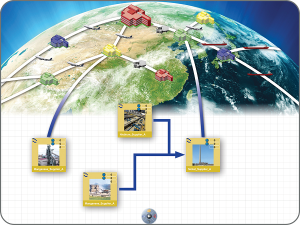 Digitalization, virtualization and automation. The digital factory’s target consists in achieving a complete planning, a constant assessment and improvement of all essential structures, processes and resources of a real factory.
Digitalization, virtualization and automation. The digital factory’s target consists in achieving a complete planning, a constant assessment and improvement of all essential structures, processes and resources of a real factory.
Digital factory instruments, whose realistic simulations are a fundamental element, will become more and more important in the Industry 4.0 era, offering a decisive contribution in the creation of flexible and modular production systems, in the integrated management of maintenance and adaptive logistics.
The best process for the best product
The first key question is what product can be manufactured at best in efficient and cheap way, granting the necessary quality, and in what versions/variants. The optimal answer to this kind of requests we must search for 3D simulation, which permits to programmers to observe and to analyse a project in highly realistic manner, evaluating a product in each stage of its implementation and being able both to decide what machine and what operator will carry out determinate machining phases, and when, and to see the effects of their decisions at once.
The other fundamental requirement at issue consists in satisfying in the shortest possible times the demand for higher product variety and/or customization, as well as the variability of a strongly fluctuating demand. To deal with these problems successfully, it is mandatory to rely on flexible and modular production systems, with smart software solutions that allow adapting workstations to product variants with flexibility and versatility. In manufacturing contexts characterized by a broad array of products and by several customization requests, it is necessary to identify “repeatable” components and to couple them with the relative machining phases: MES (Manufacturing Execution Systems) verify in what stages products can remain on the same production line and when on the contrary they must be sent to a specific station. According to a description of products and of the functions of production modules, a simulation of the contingent situation of the job order determines the optimal layout of the plant. The transmitted data are integrated into the manufacturing process thus generating new capacities, new delivery programmes and new performance levels in production. The real time monitoring of processes allows checking plants and suppliers, permitting moreover harmonizing the operating standards for the integral production control worldwide. All that allows implementing innovative ideas in a product and manufacturing it in fast and efficient way, with competitive costs and a faster time-to market. Thanks to the integration in the whole company between operation technology (OT) and information technology (IT) there will be a single design environment and, in general, a more effective use of corporate resources, improving productivity and profitability.
Maintenance in a flexible infrastructure
The capability of suitably organizing maintenance activities for the new infrastructural context is another aspect of fundamental importance. Repairs not only must be started, executed and monitored quickly but they must be also programmed in the ambit of manufacturing activities, to avoid interfering with the process. This results in a series of requisites that the software systems of the digital factory must be able to satisfy, first of all showing maintenance personnel a clear and exhaustive summary of the necessary interventions to be carried periodically. The second need is the availability of real time information showing the status of maintenance and repair interventions in course and signalling the occurrence of defects or failures on machines and plants. Third and last aspect, the software should be integrated with MES so that all maintenance and repair interventions become integral part of production. Besides, data in real time allow adapting process parameters to the contingent use of the capacity of a production line. If temporary and localized bottlenecks occur, for instance, the speed of upstream and downstream production resources can be decreased without affecting manufacturing performances. Likewise, the speed can be raised to the maximum in case of orders with urgent delivery terms. Operators specify the targets and directly work with forecasting tools.



